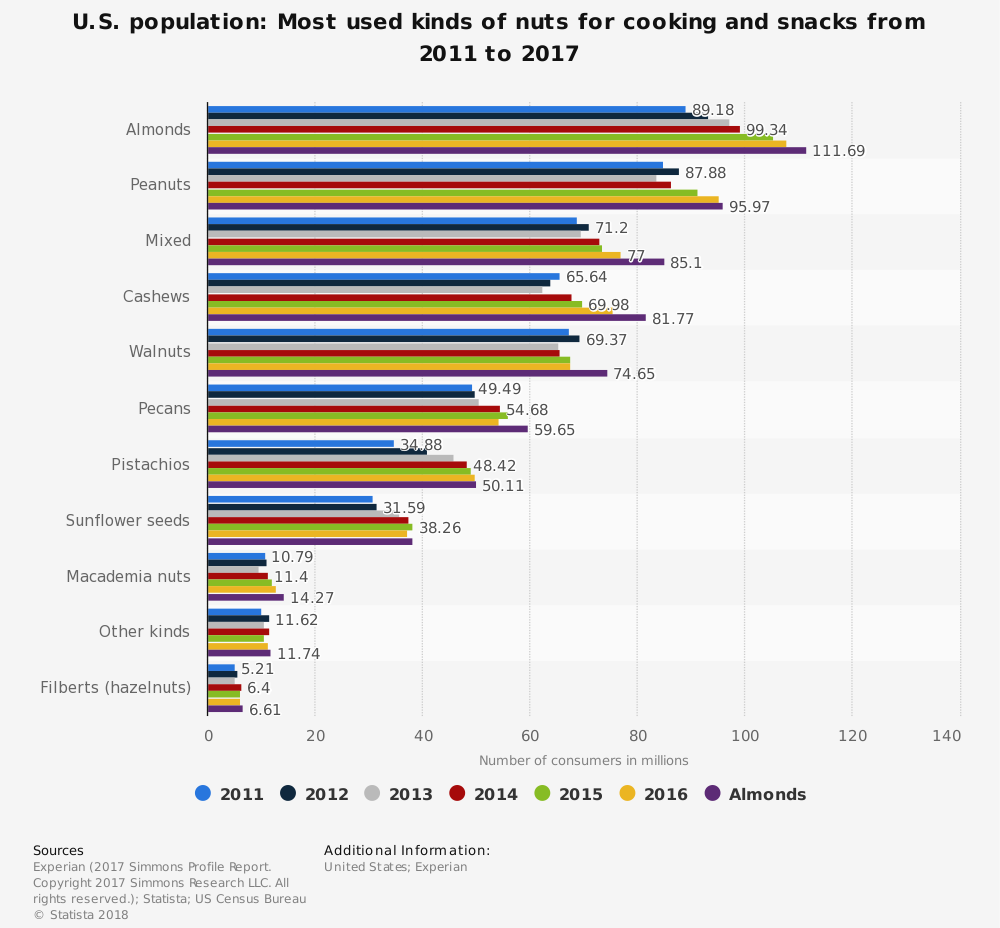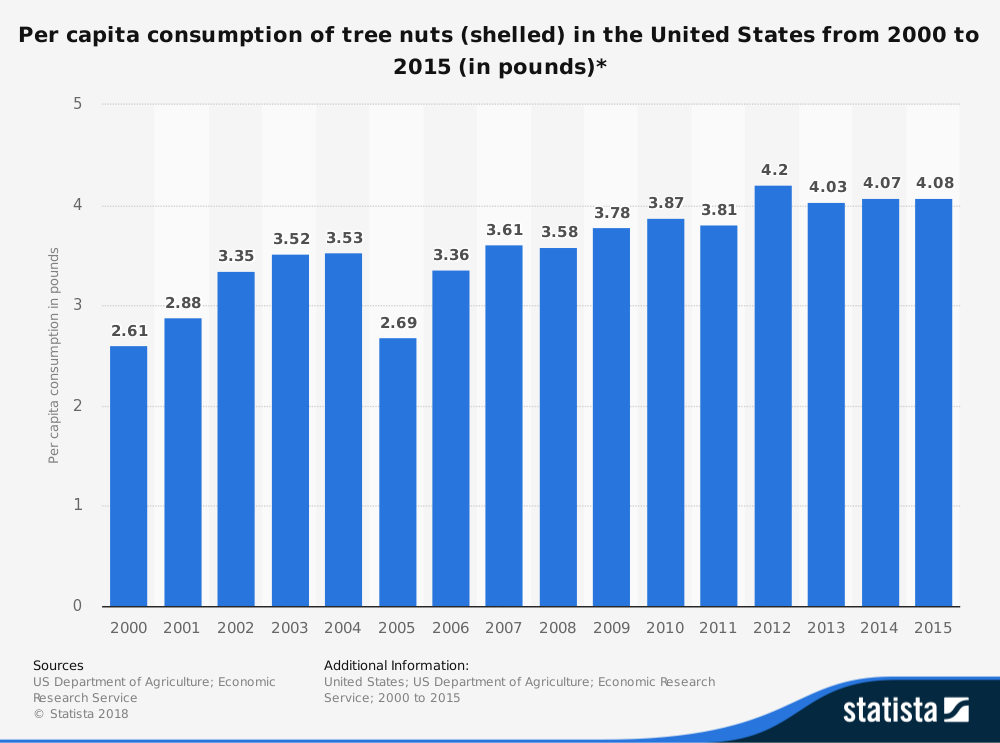Hazelnuts are often combined with chocolate to create certain products, such as Nutella. They can also be used to make praline. Evidence suggests that there has been some type of hazelnut industry present on our planet for at least 9,000 years, thanks to archeological finds from the island of Colonsay, in Scotland.
In the United States, a majority of the hazelnuts that are produced come from the State of Oregon. The first cultured hazelnut tree was planted in Oregon in 1858.
The hazelnuts are unique because they fall out of their husk when they are ripe. From pollination to harvest, it takes about 7-8 months to generate a hazelnut harvest. Once collected, hazelnuts can be used in a variety of ways. They can be eaten raw. They can be roasted. They can also be ground into a paste, ground into powder, or chopped to be used in a variety of productions.
Interesting Hazelnut Industry Statistics
#1. In the State of Oregon, there are about 800 hazelnut farms that are currently operating within the industry. In total, about 67,000 acres are dedicated to hazelnut growing in the state. Many families in the industry are third- or fourth-generation farmers. (Oregon Hazelnuts)
#2. Hazelnuts became the official nut of Oregon in 1989. Over the past 5 years, the hazelnut crop in Oregon has had an average value of about $70 million. That translates into more than $150 million in economic activities for the state. (Oregon Hazelnuts)

#3. A hazelnut tree can produce fruit for more than 100 years. It is unique in the fact that it blooms and pollinates during the winter months instead of the spring months. (Oregon Hazelnuts)
#4. Turkey is the world’s leading producer of hazelnuts. They are responsible for about 75% of the total global production. Italy is responsible for about 12% of the global market, while the United States, a mostly domestic market, accounts for just under 6% of the hazelnut supply. (Mobile Cuisine)
#5. Commercial hazelnuts are grown in only a handful of countries outside of Turkey and the United States. Italy, Greece, Georgia, Serbia, Spain, and the United Kingdom are all part of the hazelnut industry. (Mobile Cuisine)
#6. Through direct and indirect employment, about 4 million people have jobs because of the hazelnut industry in Turkey. An estimated 400,000 households are solely dependent on the income they generate by working with hazelnuts. (International Horticultural Congress)
#7. About 95% of the hazelnut production which occurs in Turkey is centralized in the Giresun, Duzce, Trabzon, Samsun, and Sakarya provinces. (International Horticultural Congress)
#8. In 2015, more than 700,000 hectares of hazelnut trees were planted in Turkey. This resulted in a production level of 646,000 tons of hazelnuts, which was about 30% higher than the year before, but about 14,000 tons short of the 2012 harvest. (International Horticultural Congress)
#9. In 2015, 910kg of hazelnuts were produced per planted hectare. Only 2012 had a higher yield, averaging 940kg per hectare. (International Horticultural Congress)
#10. The hazelnut industry in Turkey produced export revenues of $2.82 billion in 2015. That was more than $500 million more in revenues from the year before and over $1 billion more than the record yield year of 2012 for the industry. (International Horticultural Congress)

#11. 70% of the hazelnuts that are grown in Turkey are destined to be used by the global chocolate industry. Just 10% of the hazelnuts that are grown in the world today are sold as unprocessed products. (International Horticultural Congress)
#12. About 300 companies in Turkey are responsible for the storage and care of the hazelnut crop each year. 60 of these companies export more than $1 million in product every year. (International Horticultural Congress)
#13. Turkey is also responsible for about 85% of the world’s exports for hazelnut kernels that are exported, with more than 50 countries receiving their products. European nations account for almost 90% of the total hazelnut exports, with Germany receiving about half of the overall European share. (International Horticultural Congress)
#14. In Turkey, there are just 16 traditional commercial types of hazelnuts currently grown. Another 7 new types of hazelnuts are currently awaiting authorization by the Hazelnut Research Institute to be grown. (International Horticultural Congress)
#15. The town of Ordu, in Turkey, is solely responsible for growing 25% of the hazelnuts that the world consumes every year. (Quartz)
#16. Italy and Spain both produce about 100,000 tons of hazelnuts annually for the global market, though some years, production levels can be as low as 10,000 tons. (Food Turkey)
#17. In the United States, domestic hazelnut growth supplies a majority of the market for Americans. Small levels of imports are brought in to supplement years where higher levels of demand occur. (Food Turkey)
#18. Hazelnut consumption, per person, is highest in Italy for countries that produce hazelnuts. The average person with eat 0.52kg of hazelnut kernels each year. Greece is second, at 0.36kg per person, while Turkey is third, at 0.25kg per person. This data, however, was collected in 1993. (Food Turkey)
#19. Switzerland consumes the most hazelnut products in the world, with each person consuming an average of 2.09kg each year. (Food Turkey)
#20. The Oregon hazelnut industry produces 99% of the hazelnuts that are consumed in the United States. They are also responsible for 50% of the exports in the industry that the U.S. is able to achieve each year. (Oregon Hazelnuts)

#21. In 2016, Oregon produced 43.3 tons of hazelnuts, harvesting 40% more than the previous year, and outperformed projections by 14%. (Capital Press)
Hazelnut Industry Trends and Forecast
The global hazelnut industry is projected to achieve a market value of $12 billion by the year 2026. One of the biggest factors that will determine the overall growth of the industry is if new products can be developed from the shell of the hazelnut. In 2016, there were 90,000 metric tons of hazelnut shells consumed around the world.
Hazelnut shells currently account for just 1% of the revenues that this product generates globally each year.
If these revenue figures are achieved, then the hazelnut industry would have a CAGR of 5.9% for the end of the forecast period.
Demand for hazelnut products is expected to grow at high levels in the next 5-year and 10-year period. About 80% of the growth expected by the industry comes from the food and beverage industry. Coffee and chocolate products are especially interested in new and innovative approaches that use hazelnut products.
It isn’t just the food industry that is interested in hazelnuts either. More than $1 billion of hazelnuts are forecast to be sold to cosmetic manufacturers and pharmaceutical agencies in the forecast period.
Although millions of people visit Brandon's blog each month, his path to success was not easy. Go here to read his incredible story, "From Disabled and $500k in Debt to a Pro Blogger with 5 Million Monthly Visitors." If you want to send Brandon a quick message, then visit his contact page here.
